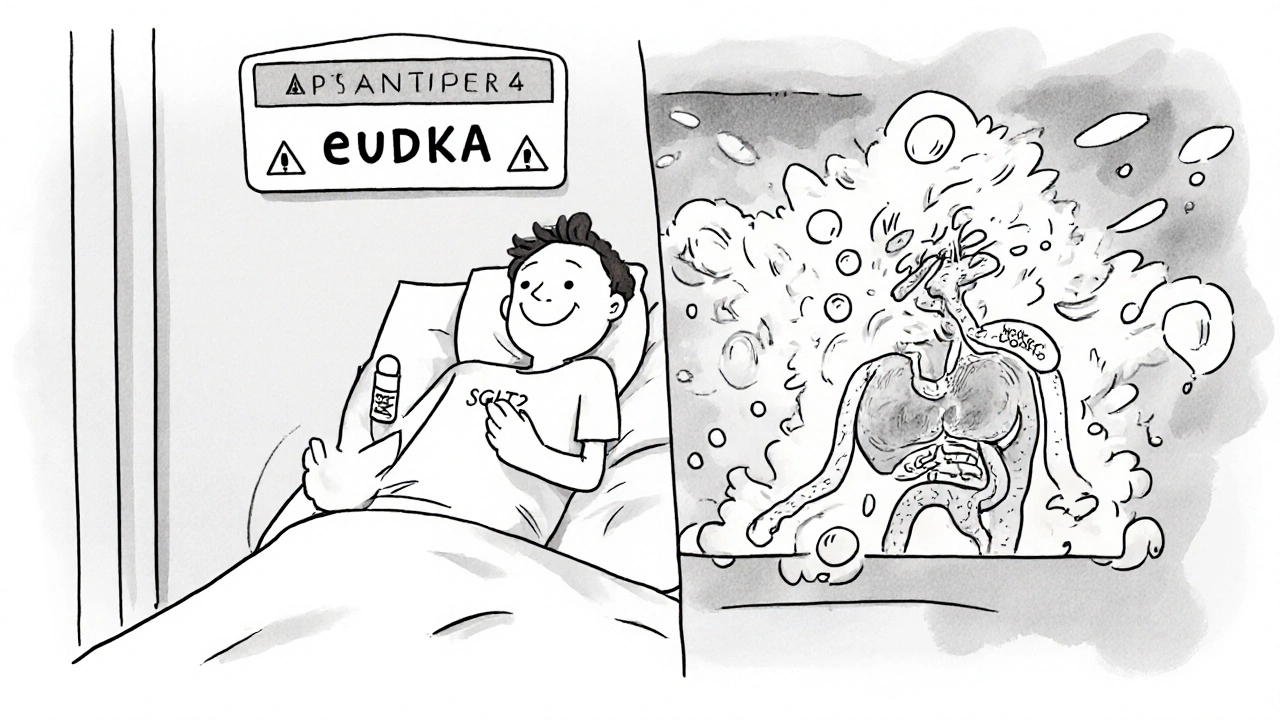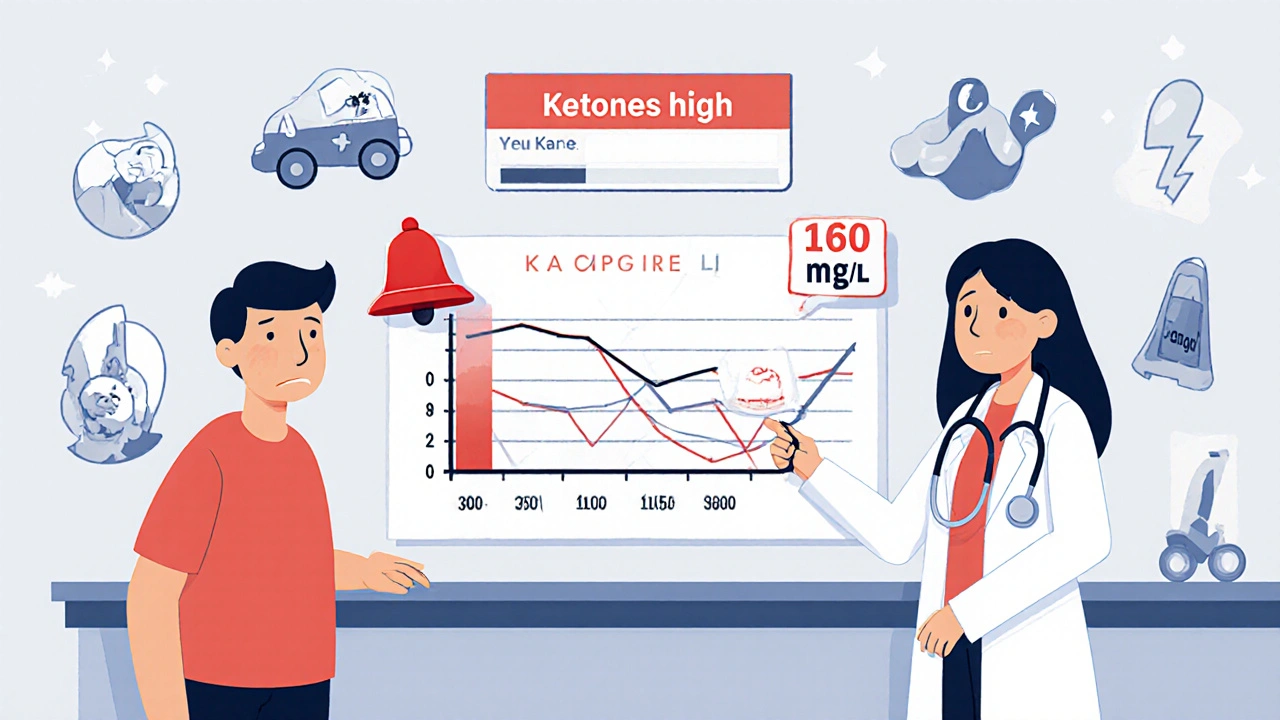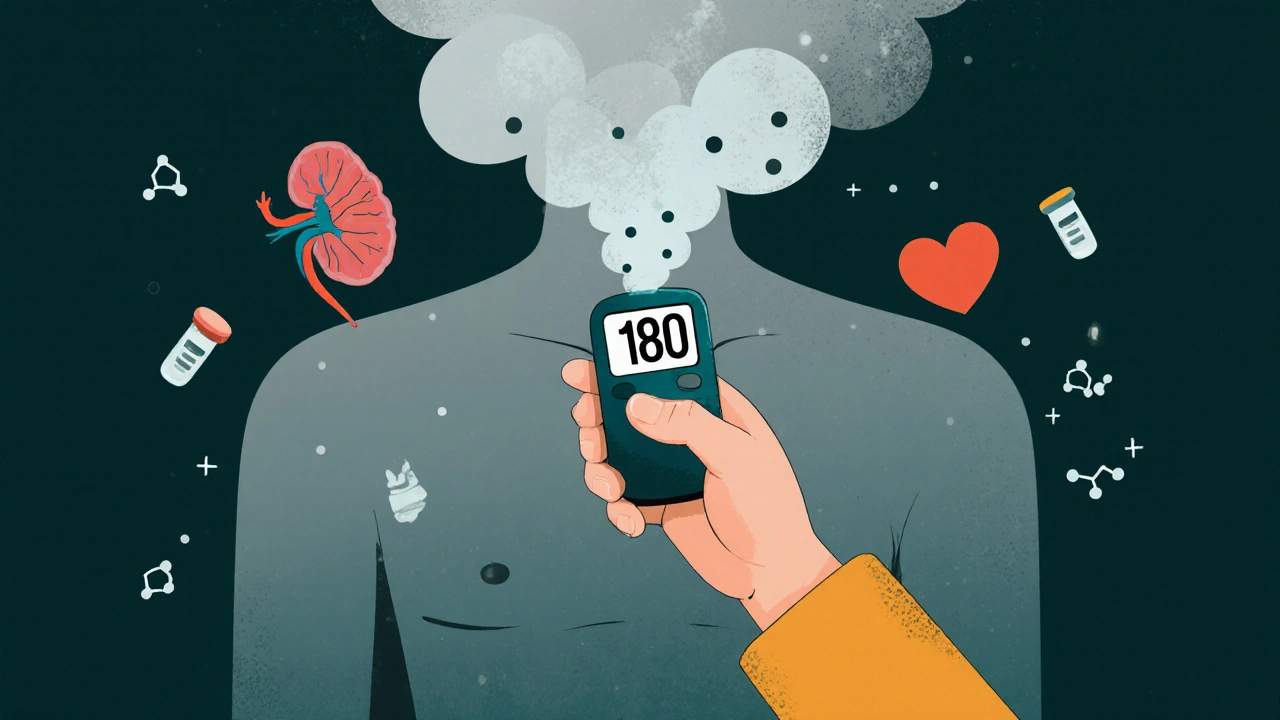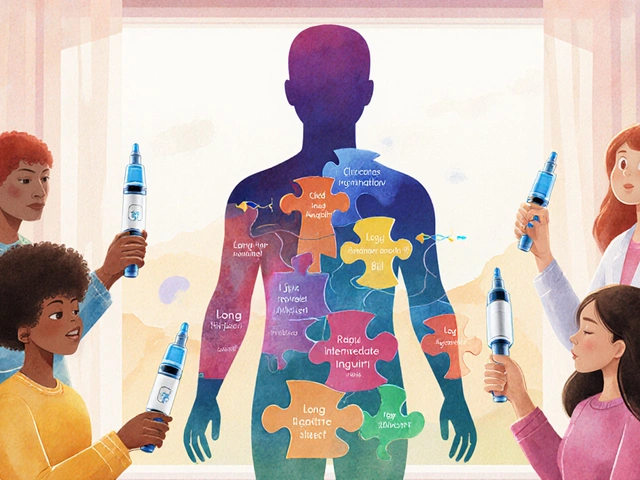When you're managing type 2 diabetes, finding a medication that lowers blood sugar without causing side effects is the goal. SGLT2 inhibitors like canagliflozin, dapagliflozin, and empagliflozin have been widely prescribed because they do more than just reduce glucose-they’ve been shown to protect the heart and kidneys. But there’s a hidden danger many patients and even some doctors don’t recognize: diabetic ketoacidosis (DKA), especially when blood sugar isn’t high.
What Makes SGLT2 Inhibitors Different?
SGLT2 inhibitors work by making your kidneys flush out extra sugar through urine. That’s why they’re effective: they don’t rely on insulin to lower blood sugar. Instead, they remove glucose the body can’t use. This mechanism also lowers blood pressure and reduces weight, which is why they’re popular in clinical practice.
But here’s the catch: when sugar leaves the body through urine, your body starts looking for other energy sources. That means fat breaks down faster, producing ketones. Normally, that’s not a problem-your body can handle it. But in some people, especially under stress, ketones build up too fast. And when that happens, you can develop DKA.
What’s unusual about SGLT2 inhibitor-related DKA is that it often happens with blood sugar levels below 250 mg/dL. This is called euglycemic DKA (euDKA). It’s misleading because most people think DKA only occurs when blood sugar is sky-high. If your glucose is only 180 or 200 mg/dL and you feel sick, you might not suspect DKA. That delay can be deadly.
Who’s Most at Risk?
Not everyone on SGLT2 inhibitors will get DKA. But certain factors raise the risk significantly.
- Insulin deficiency: Patients with low C-peptide levels (under 1.0 ng/mL) are more likely to develop euDKA because their bodies can’t make enough insulin to stop ketone production.
- Acute illness: Infections, flu, or even a bad cold can trigger DKA in someone on these drugs. The body’s stress response increases fat breakdown and reduces insulin sensitivity.
- Reduced food intake: Skipping meals, fasting, or going on a low-carb diet while on an SGLT2 inhibitor can push the body into ketosis faster.
- Surgery or procedures: Any time you’re told to fast before surgery, your doctor should tell you to stop the SGLT2 inhibitor at least 3 days ahead.
- Alcohol use: Heavy drinking, especially without food, increases ketone production and impairs liver function.
Studies show that 63% of DKA cases linked to these drugs happen within the first year of use. The median time to onset? Just 28 weeks. That means the risk isn’t just at the start-it’s a constant consideration.
Why Is euDKA So Dangerous?
Traditional DKA is easier to spot. High blood sugar, fruity breath, nausea, vomiting, confusion-clear signs. But euDKA? Symptoms are subtle. You might feel tired, have abdominal pain, breathe faster than usual, or just feel “off.” Blood sugar might be 160 mg/dL. You check it, think it’s fine, and keep going. That’s the trap.
According to the FDA’s adverse event database from 2013 to 2022, nearly half (48.7%) of DKA cases in SGLT2 inhibitor users were euDKA. And here’s the scary part: the death rate for euDKA linked to these drugs is 4.3%, compared to 2.1% for classic DKA. Why? Because it’s missed. By the time it’s diagnosed, the acidosis is severe.
Dr. Anne Peters from USC says euDKA makes up 30-40% of all DKA cases in patients taking SGLT2 inhibitors. That’s not rare. That’s common enough that every provider should assume it until proven otherwise.

What Do the Experts Say?
Regulatory agencies have been clear. The FDA first warned about this in 2015. The European Medicines Agency (EMA) updated its safety guidance in June 2023, specifically highlighting euDKA as a serious, under-recognized risk. The UK’s MHRA and Canada’s Health Canada have issued similar alerts.
The American Diabetes Association’s 2023 Standards of Care state: “SGLT2 inhibitors have been associated with DKA, which may present with only modestly elevated blood glucose levels.” That’s not a footnote. It’s a major warning.
But here’s where it gets confusing. Some studies say the risk is low. A 2023 meta-analysis of over 71,000 patients found no significant increase in DKA risk compared to placebo. Others show a nearly threefold increase. Why the contradiction?
It comes down to context. Most of the “no risk” studies were short-term trials with healthy patients. Real-world data-like the Canadian and UK health records involving over 350,000 people-show a clear signal. The difference? Real patients get sick. They skip meals. They reduce insulin. They don’t check ketones. The trials didn’t capture that.
How to Stay Safe
If you’re on an SGLT2 inhibitor, here’s what you need to do:
- Know the symptoms: Nausea, vomiting, stomach pain, unusual fatigue, trouble breathing, confusion. Don’t wait for high blood sugar.
- Check ketones when you’re sick: Use urine strips or a blood ketone meter. If ketones are moderate or high, call your doctor-even if your glucose is 180 mg/dL.
- Stop the drug before surgery: Tell your surgeon you’re on an SGLT2 inhibitor. They should tell you to stop it 3 days before.
- Don’t go low-carb without talking to your doctor: Keto diets and SGLT2 inhibitors are a dangerous mix.
- Never skip insulin: If you’re on insulin and an SGLT2 inhibitor, don’t reduce your insulin dose without medical advice.
A 2022 study in Diabetes Care showed that when patients were taught to check ketones and recognize symptoms, DKA cases dropped by 67%. Education works.
Who Should Avoid These Drugs?
SGLT2 inhibitors aren’t for everyone. The American Diabetes Association recommends avoiding them if you have:
- A history of DKA
- Type 1 diabetes (unless under strict supervision)
- Very low insulin production (C-peptide < 1.0 ng/mL)
- Chronic conditions that cause dehydration or low blood volume
If you’ve had DKA before-even years ago-these drugs could trigger it again. The risk doesn’t go away.

The Bigger Picture: Benefits vs. Risk
Let’s be clear: SGLT2 inhibitors save lives. In the EMPA-REG OUTCOME trial, empagliflozin reduced heart failure hospitalizations by 35% and cardiovascular death by 38%. Dapagliflozin reduced kidney failure in patients with chronic kidney disease by 44%. These aren’t small wins.
The absolute risk of DKA? About 0.1 to 0.5 cases per 100 patients per year. That’s low. But it’s not zero. And when it happens, it’s serious.
The consensus now? For most people with type 2 diabetes, the benefits outweigh the risks-if you’re monitored properly. But for those with risk factors, the risk isn’t worth it.
What’s Next?
Researchers are working on solutions. One new drug, licogliflozin, is a dual SGLT1/SGLT2 inhibitor that may be less likely to cause ketosis because it slows sugar absorption in the gut. It’s in phase 3 trials.
Machine learning models are being developed to predict who’s most likely to develop euDKA. One 2024 study in Lancet Digital Health built a model using 15 variables-like age, kidney function, insulin use, and recent illness-that predicted risk with 87% accuracy.
And the FDA now requires all new SGLT2 inhibitor trials to include specific monitoring for euDKA. That means future drugs may come with better safety profiles.
But for now, the message is simple: know your risk. Know the symptoms. Check ketones when you’re sick. Don’t assume low blood sugar means you’re safe.
Can SGLT2 inhibitors cause DKA even if my blood sugar is normal?
Yes. This is called euglycemic DKA (euDKA), and it’s a known risk with SGLT2 inhibitors. Blood sugar may be below 250 mg/dL-even as low as 120-180 mg/dL-while ketones build up and cause dangerous acidosis. Symptoms like nausea, vomiting, fatigue, and rapid breathing can appear without high glucose levels, making diagnosis harder.
Should I stop taking my SGLT2 inhibitor if I get sick?
Yes, temporarily. If you have an infection, flu, surgery, or any acute illness, stop your SGLT2 inhibitor and contact your doctor. Your body needs insulin to manage stress, and these drugs can interfere with that balance. Restart only after you’re fully recovered and your doctor says it’s safe.
Do I need to check ketones regularly while on SGLT2 inhibitors?
Not daily, but yes-when you’re ill, fasting, or feeling unwell. If you have symptoms like nausea, vomiting, or abdominal pain, check your ketones with a urine strip or blood meter. If ketones are moderate or high, seek medical help immediately-even if your blood sugar is normal.
Are SGLT2 inhibitors safe for people with type 1 diabetes?
Generally, no. SGLT2 inhibitors are not approved for type 1 diabetes in most countries. However, some doctors use them off-label with extreme caution in select patients who have good insulin control and are closely monitored. The risk of euDKA is much higher in type 1 diabetes, so this is only done under specialist supervision.
What should I do if I suspect I have DKA?
Don’t wait. If you have nausea, vomiting, stomach pain, rapid breathing, confusion, or extreme fatigue-especially while on an SGLT2 inhibitor-check your ketones. If they’re moderate or high, go to the emergency room immediately. Do not try to treat this at home. euDKA can worsen quickly and requires IV fluids and insulin in a hospital setting.
Final Thought
SGLT2 inhibitors are powerful tools-but they’re not magic pills. They work best when used with awareness. If you’re taking one, make sure you understand the signs of euDKA. Talk to your doctor about your personal risk. Keep ketone strips on hand. And never ignore symptoms just because your glucose monitor looks okay. Your life depends on seeing the full picture-not just the number on the screen.





Comments
SGLT2 inhibitors are a game-changer-until they’re not. I’ve seen patients crash into euDKA with glucose at 170 and no warning. No fruity breath, no skyrocketing numbers-just fatigue, nausea, and then BOOM, ICU. Doctors keep acting like it’s rare, but it’s not. It’s lurking. And if you’re on one of these drugs and you feel off? Don’t wait for the meter to scream. Check ketones. Now.
I appreciate the depth of this post. It’s alarming how many clinicians still treat DKA as a high-glucose-only scenario. The EMA’s 2023 update is a wake-up call, and the fact that nearly half of cases are euDKA is not a footnote-it’s a red flag. Patients need to be educated, not just prescribed. And yes, ketone strips should be as common as glucometers.
yo why u all making such a big deal? in india we use these drugs for years and no one dies. u americans overthink everything. my uncle on dapagliflozin and he runs marathons. u just need to eat roti and not be lazy. problem solved. stop fearmongering.
While I acknowledge the clinical significance of euDKA, I must note that the risk-benefit ratio remains favorable for the majority of patients. The FDA’s warnings are appropriately calibrated, and the data from large-scale trials do not support widespread alarmism. Education is key, but so is proportionality.
My dad’s on empagliflozin. He got sick with the flu last winter, didn’t stop the med, and ended up in the ER with ketones at 3.2 and glucose at 185. No one thought it was DKA until he was blue. Now he keeps ketone strips in his wallet. If you’re on one of these, do the same. It’s not complicated. Just don’t ignore the signs.
Another ‘meds are dangerous’ post. Let’s be real-99% of people on SGLT2 inhibitors are fine. The 1% who get euDKA? Usually they’re non-compliant, fasting, drinking, or on insulin without supervision. This isn’t a drug problem. It’s a patient behavior problem. Stop blaming the medicine.
bro i just started canagliflozin last week and i’ve been feeling kinda weird lately… kinda dizzy, stomach hurts a bit… should i be scared? i dont wanna go to the doc for nothing but idk…
As someone from India, I’ve seen this firsthand-many patients don’t even know what ketones are. We need community health workers to teach simple things: ‘If you’re sick, stop the pill. Check your urine with the strip. Call your doctor.’ No fancy tech needed. Just basic awareness. This post should be translated into Hindi, Tamil, Bengali-every language.
The literature consistently demonstrates that euDKA incidence is elevated in populations with low C-peptide levels, particularly those with latent autoimmune diabetes in adults (LADA). This is not merely a pharmacological artifact-it is a pathophysiological consequence of insulinopenia exacerbated by SGLT2 inhibition. Monitoring should be stratified accordingly.
People are dying because doctors are lazy. 😭 I had a friend who went to the ER with vomiting and a glucose of 190. They told her to ‘drink water and wait.’ She coded 3 hours later. This isn’t ‘rare.’ It’s negligence. SGLT2 inhibitors should come with a warning label bigger than the bottle. 🚨
Let me tell you something-this whole thing is a scam. Big Pharma pushes these drugs because they make billions. They know euDKA is dangerous, but they bury the data. Look at the trials-only healthy patients included. Real people? They’re sick. They skip meals. They drink. And now they’re dead. And who gets sued? The patient. Not the company.
I’m on dapagliflozin and I’m so glad I found this. I started checking ketones when I’m sick-and I caught a mild spike before it got bad. No ER visit. No IVs. Just a call to my doc and a few days off the med. It’s not scary if you’re prepared. Knowledge is power, seriously.
It is with profound regret that I must observe the current state of medical discourse, wherein empirical data is supplanted by anecdotal exhortations and alarmist vernacular. The incidence of euDKA, while statistically non-negligible, remains statistically insignificant when contextualized within the broader therapeutic landscape. One must not confuse correlation with causation, nor emotion with evidence.
Just got back from my endo. She gave me ketone strips and said ‘if you feel off, check them.’ Simple. No drama. I keep them next to my coffee maker now. 😎
It is imperative that patients, especially those residing in regions with limited access to healthcare, be made aware of the potential for euDKA. The absence of hyperglycemia should not be misconstrued as an absence of risk. Vigilance, not fear, is the appropriate response.
Most of these comments are emotional overreactions. The risk is 0.1% per year. You’re more likely to die from a fall in the shower. Stop panicking. The real issue is that people don’t understand how to use these drugs safely-not that the drugs are dangerous.
Wait, so if I’m on one of these and I fast for 16 hours for intermittent fasting… am I at risk? I thought that was healthy? I’m confused now. I don’t want to stop the med, but I don’t want to end up in the hospital either.